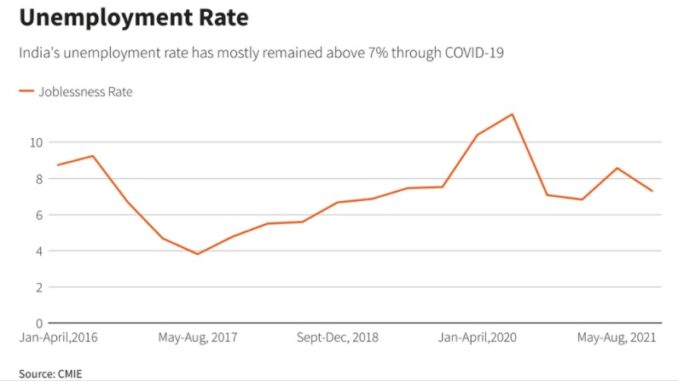
- India unemployment averaged 7.2% in 2018-2021 vs global average around 5.7%
- Nation’s job participation rate is low and falling
- GDP growth providing fewer jobs than in the 1970s and 80s
- Lack of employment opportunities a risk to PM Modi as elections loom
Nation’s unemployment is estimated to have exceeded the global rate in five of the last six years, data from Mumbai-based the Centre for Monitoring Indian Economy (CMIE) and International Labour Organization show, due to an economic slowdown that was exacerbated by the pandemic. Having peaked at 23.5% in April 2020, Nation’s joblessness rate dropped to 7.9% last month, according to CMIE. The rate in Canada fell to a multi-month-low of 5.9% in December, while the OECD group of mostly rich countries reported a six straight month of decline in October, with countries including the United States suffering labour shortages as economic activity picks up.
What’s worse for India, its economic growth is producing fewer jobs than it used to, and as disheartened jobseekers instead take menial roles or look to move overseas, the country’s already low rate of workforce participation – those aged 15 and above in work or looking for it – is falling.
VOCAL FOR LOCAL
Critics say such hopelessness among Nation’s youth is one of the biggest failures of Prime Minister Narendra Modi, who first came to power in 2014 with his as yet unfulfilled promise of creating millions of jobs.
It also risks India wasting its demographic advantage of having more than two-thirds of its 1.35 billion people of working age.
The ministries of labour and finance did not respond to requests for comment. The labour ministry’s career website had more than 13 million active jobseekers as of last month, with only 220,000 vacancies.
The ministry told parliament in December that “employment generation coupled with improving employability is the priority of the government”, highlighting its focus on small businesses.
Modi’s rivals are now trying to tap into the crisis ahead of elections in five states, including Punjab and most populous Uttar Pradesh, in February and March.
“Because of a lack of employment opportunities here, every kid looks at Canada. Parents hope to somehow send their kids to Canada,” Delhi Chief Minister Arvind Kejriwal, whose Aam Aadmi Party is a front-runner in Punjab elections, told a recent public function there.
“I assure you, within five years they will start returning because we will create so many opportunities for them here.”
He did not explain, but party workers said their policies would attract job-creating businesses.
Punjab’s neighbour Haryana, home to local offices of many global IT companies and an automobiles hub, has already ordered that most jobs there be reserved for locals. A political party in Punjab has promised something similar if voted to power.
“To an extent, if a particular sector is doing well, then some arrangements can be made to ensure that local youth get opportunities,” said Amit Basole, head of the Centre for Sustainable Employment in Azim Premji University in Bengaluru.
“But if overall job creation is weak, then such policies do not solve the underlying problem. And they may also make things worse by reducing investment.”
CMIE’s Vyas said India needs more investment in labour-intensive industries and should bring more woman into the labour force, Like Bangladesh has done through its garment factories.
“NO ONE DELIVERS”
Between 2018 and 2021, India suffered its longest period of slowdown since 1991, with unemployment averaging 7.2%, CMIE data shows. Global unemployment averaged around 5.7% in that period.
The jobs shortage is particularly problematic for a country like India where annually 12 million people reach employment age. The economy has not grown fast enough to absorb so many people, economists say.
Also, the increase in workforce for every percent rise in gross domestic product has shrunk: the economy will have to grow at 10% to raise employment by 1%, said Basole of Azim Premji University. In the 1970s and 1980s, when GDP growth was 3% to 4%, employment grew around 2%, Basole has found.






